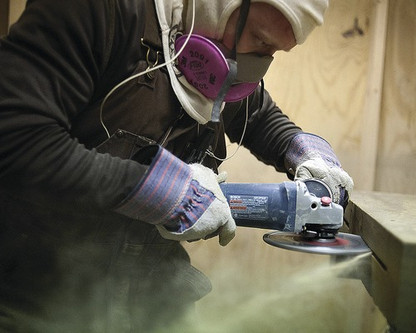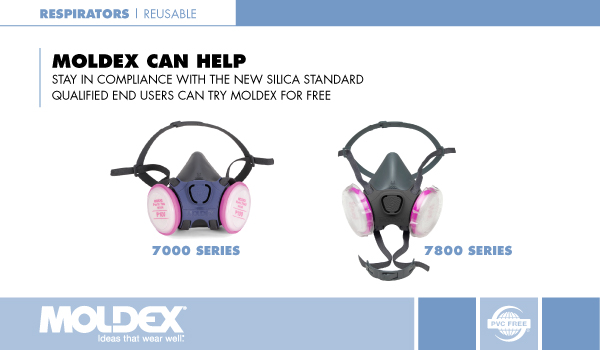How Do the New OSHA Crystalline Silica Rules Affect Construction Companies?
Crystalline silica is a common mineral that is found in materials that construction workers deal with every day – such as roads, buildings, and sidewalks. It is a common component of sand, stone, rock, concrete, brick, block and mortar. Common workplace operations involving cutting, sawing, drilling, and crushing of these materials often create crystalline silica dust exposure in construction. Scientific evidence shows that current exposure limits do not adequately protect worker health. The new OSHA Construction Standard will help to fully protect workers against dangers of exposure to respirable crystalline silica in the workplace. OSHA’s new standards to protect workers in construction are set to roll out this weekend, on September 23, 2017.
Here are the New Requirements for Construction Employers:
- Design and implement an exposure control plan that identifies tasks that involve exposure and methods used to protect workers,
- Designate a competent person to implement the written exposure control plan,
- Restrict housekeeping practices that expose workers to silica where feasible alternatives are available,
- Offer medical exams (chest X-rays, lung function tests) every 3 years for workers who are exposed at or above the action level and are required to wear a respirator for 30 days or more per year,
- Provide training for workers on the operations that result in silica exposure and ways to limit exposure to crystalline silica,
- Keep records of workers’ silica exposure and their medical exams.
OSHA allows for two alternative methods of ensuring compliance with these requirements: standard control methods specified in the Table: SPECIFIED EXPOSURE CONTROL METHODS WHEN WORKING WITH MATERIALS CONTAINING CRYSTALLINE SILICA that match common tasks with dust control methods, or the alternative control methods mentioned below.
Crystalline Silica Exposure Alternative Control Methods:
- Measure the amount of silica that workers are exposed to. Is it at or above the action level of 25 micrograms per cubic meter of air, averaged over an 8-hour workday?
- Protect workers from respirable crystalline silica exposures above the permissible exposure limit (PEL) of 50 micrograms per cubic meter of air, averaged over an 8-hour workday.
- Use dust controls.
- Provide respirators that have been properly fit tested to the worker when dust controls cannot limit exposures to the PEL.
Compliance Schedule:
OSHA Standards contained in the final rule took effect on June 23, 2017, but the enforcement was delayed to September 23rd. Industries have one to five years to comply with the requirements, based on the following compliance schedule:
- Construction: September 23, 2017. OSHA delayed enforcement in order to conduct additional outreach and provide more guidance for employers.
- General Industry and Maritime: June 23, 2018, two years after the effective date.
- Hydraulic Fracturing: June 23, 2018, two years after the effective date for all provisions except Engineering Controls, which have the compliance date of June 23, 2021.
You can find additional information on OSHA’s silica rule at https://www.osha.gov/dsg/topics/silicacrystalline/. OSHA can provide extensive help through different programs, including technical assistance about effective safety and health programs, workplace consultations, and training and education.
One of the most effective ways to protect against silica is using the appropriate respirators. The best-selling 7000 and 7800 series respirators by Moldex will ensure complete protection against crystalline silica and other harmful agents. However, a respirator can't protect you if it doesn't fit properly. A respirator must form a tight seal with your face and neck to function properly. This is why it is important to perform a respirator fit test before starting projects that involve exposure to silica. Moldex can help you stay in compliance with the new silica standard. Qualified safety managers and company buyers can check out a sample of Moldex respiratory or hearing protection products for free: http://www.moldex.com/spisafety/
How do you know if you are providing enough protection? Talk to us at 800-829-9580 or visit us online. We have the right respirators and safety gear to help protect your crew and keep your company OSHA compliant.
Recent Posts
-
April 28 is Workers Memorial Day
Your job shouldn't cost your life, but for some, this has unfortunately been the case. Wo …Apr 26th 2024 -
Promoting Safety: National Work Zone Awareness Week is April 15-19, 2024
Each year, the National Work Zone Awareness Week (NWZAW) places the spotlight on the importance o …Apr 11th 2024 -
Understanding 4 Gas Monitors: How They Work & Why They Are Important
In today’s increasingly dynamic industrial landscape, 4 gas monitors have emerged as critical com …Apr 8th 2024






